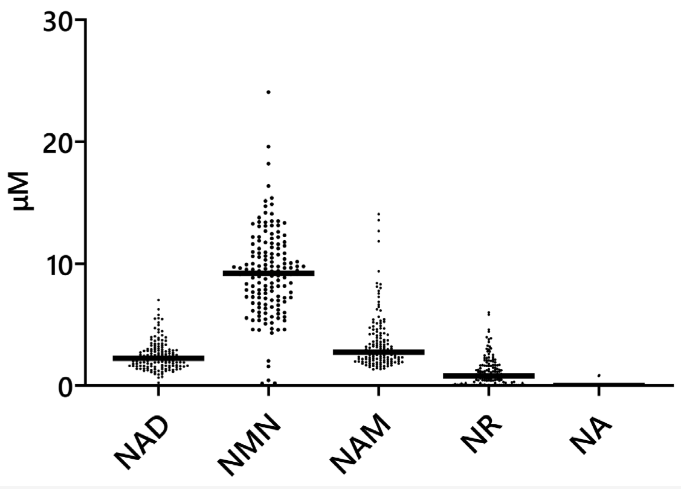This groundbreaking study, the first of its kind, investigated the prevalence and quantities of NAD, NMN, NAM, NR and NA in breast milk and its effect on early infant neurodevelopment.
“NMN is known to exhibit anti-aging effects, and these results suggest that this compound may also have important roles even in infancy.”
Key Points:
- The most abundant NAD precursor identified was NMN
- NMN levels in breast milk are linked to infant neurodevelopmental outcome
- NMN was stable in breast milk, NR was not
- Positive effects on development may be impeded by the presence of NAM
“NMN had the highest concentrations in breast milk among the NAD-related substances. We demonstrated, for the first time, a positive relationship between NMN concentrations in breast milk and the neurodevelopmental outcome of a child.”
A Comprehensive Study of Breastfed Infants
150 mother-infant pairs were randomly selected and studied.
- Breast milk was collected 1-month post-partum for metabolic analysis.
- Researchers ensured that the concentrations of metabolites were not affected by storage conditions.
- Infants were exclusively breast fed for the duration of the study.
Developmental milestones were assessed at 6, 12 and 24 months of age, and they were correlated with the concentration of NAD+ metabolites.
“Human milk, in particular, is highly abundant in NMN relative to other mammalian species.”
NMN is the Most Abundant NAD+ Metabolite in Breast Milk
The researchers took great care in analyzing the quantities of NAD+, NMN, NAM, NR and NA in the milk samples.
- The concentration of NMN varied from person to person, but was still the most prevalent precursor in breast milk.
- NAD, NAM and NR were also detected, but at lower concentrations

This figure shows that the concentration of NMN in human breast milk was significantly higher than NAD, NAM, NR, and NA.
“Nicotinamide mononucleotide (NMN) was quantified as the major NAD precursor in breast milk.”
NMN Linked To Infant Neurodevelopment
Children were evaluated on their communication, problem-solving, social, and motor skills at 6, 12 and 24 months of age.
Researchers found that NMN was the only metabolite linked with the neurodevelopmental outcome in children at 24 months.
“The NMN concentration in breast milk was the only NAD-related substance in breast milk that showed a significant positive correlation with neurodevelopmental outcome in infants at 24 months.”
NMN is More Stable than NR
NMN showed stability in breast milk.
“NMN was indeed stable in breast milk at 4 °C for at least 2 weeks.”
Conversely, NR is not as stable as NMN and was degraded to NAM over time.
“NR was substantially reduced, while the NAM concentration increased in breast milk stored at 4 °C. The sum of the NR and NAM concentration remained constant, suggesting that NR decomposed into NAM.”
NMN stability suggests that NMN could serve as a viable source of NAD precursors for infants.
“Since NMN is more stable than NR in breast milk, NMN may be a suitable source of NAD precursors in breast milk.”
Interestingly, NR is stable in cow milk, but is not stable in human milk.
“Factors that degrade NR may be absent in cow milk but not in human milk.”
A 2019 study showed that supplying nursing mothers with NR boosted NAD+ in mammary tissue, enhancing pups’ health. Notably, breast milk contained minimal NR itself.
NAM May Suppress Positive Effects
The association of NMN with neurodevelopmental outcomes observed at 24 months was not seen at 6 and 12 months.
“The effect of the NMN concentration in breast milk is not apparent at 6 and 12 months of age.”
NAM in breast milk showed a negative association with some developmental measures, possibly due to its known ability to inhibit certain key enzymes.
“We also observed significant negative correlations between NAM and several developmental measures at 6 and 24 months that may be related to the negative feedback activity of NAM.”
Conclusions
NMN displayed the highest abundance in breast milk among NAD-related compounds, displaying a concentration over 10 times greater than that of NR.
“NMN is the major NAD precursor in breast milk.”
The researchers were able to link to the increased concentration of NMN in breast milk and developmental progress of the first 2 years of life.
“The results suggest that NMN in human milk may be an important nutrient for early childhood development”
“NMN in breast milk may improve child development not only through its effects on the central nervous system but also on the peripheral nervous system and muscles.”
